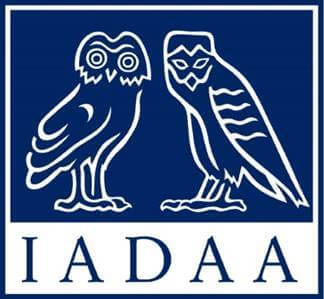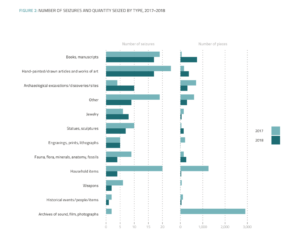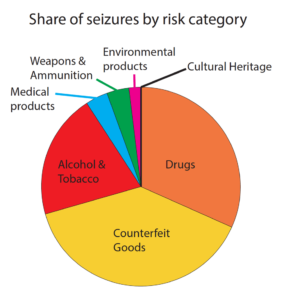The World Customs Organisation’s 200-page Illicit Trade Report 2018 shows a decline in Cultural Heritage crime, while also showing how it is dwarfed by other sectors of trafficking, such as drugs, weapons and counterfeit goods, accounting for just 0.08% of all reported cases and seizures.
The WCO has included Cultural Heritage as a category in its reporting since 2015.
The results since then expose the gross inaccuracy and exaggeration of widespread claims of a multi-billion dollar international network of trafficking and illicit trade in antiquities.
Despite the claim [now removed] on the Interpol website that illicit trade in cultural property was third only to that in drugs and weapons [a claim that Interpol itself contradicted even as it continued to publish it], the WCO figures show that this has never been the case and that, in fact, cultural property trafficking is by a very long way the smallest category of concern.
According to the WCO:
- Cultural Property made up just 0.08% of cases and seizures involving reported illicit trade globally. This was a decline by almost two thirds from 0.2% in 2017.
- Cultural Property includes all forms of art, antiques and collectables as well as other items, together forming at least 12 distinct categories, ranging from household items to flora and fauna, as well as books and manuscripts.
- The report gives no clear figures for antiquities as a category, listing the top three categories of recovered objects as Currency and Medals, Hand-painted or Hand-drawn articles and works of art, and Books and Manuscripts.
- 133 countries globally reported trafficking cases and seizures across the range of categories in 2017. Of these, 25 countries reported seizures of Cultural Property.
- 154 countries globally reported trafficking cases and seizures across the range of categories in 2018. Of these, 20 countries reported seizures of Cultural Property.
- The number of reported cases globally year on year involving Cultural Property fell from 155 to 98.
- The number of reported seizures globally involving Cultural Property fell from 193 to 123.
- The number of Cultural Property items seized globally year on year fell from 15,865 to 15,689.
- The number of archaeological items reported as seized fell by more than half, from 703 to 314.
- Outside the Russian Federation, no country in the world registered more than 15 instances of trafficking in Cultural Property.
- A total of 13,391 currency items, including but not limited to ancient coins, were recovered in 2018 compared to 9,431 in 2017.
World Customs Organisation Illicit Trade Report 2018
| 2017 | 2018 | |
| Number of reported seizures globally involving Cultural Property | 193 | 123 |
| Number of reported items seized globally involving Cultural Property | 15,865 | 15,689 |
| Number of reported items of currency seized globally | 9,431 | 13,391 |
| Number of reported archaeological items seized globally | 703 | 314 |
| % share of reported cases of illicit trade globally involving Cultural Property | 0.2% | 0.08% |
| % share of reported illicit trade seizures globally involving Cultural Property | 0.2% | 0.08% |
| Number of cases | |
| Total: | 116,249 |
| Drugs: | 45,497 (39.1%) |
| Counterfeit goods: | 34,120 (29.3%) |
| Alcohol & Tobacco: | 26,220 (22.5%) |
| Medical products: | 5,040 (4.3%) |
| Weapons & Ammunition: | 2,849 (2.4%) |
| Environmental products: | 2,425 (2.1%) |
| Cultural Heritage: | 98 (0.08%) |
| Number of seizures | |
| Total: | 154,885 |
| Drugs: | 49,440 (31.9%) |
| Counterfeit goods: | 60,134 (38.8%) |
| Alcohol & Tobacco: | 31,150 (20.1%) |
| Medical products: | 5,799 (3.7%) |
| Weapons & Ammunition: | 5,512 (3.6%) |
| Environmental products: | 2,727 (1.8%) |
| Cultural Heritage: | 123 (0.08%) |
On page 11 the 2018 report describes the top three categories as “Currency and Medals, Hand-painted or Hand-drawn articles and Works of Art and Books and Manuscripts”.
The report notes that the number of seizures among currency and medals decreased from 68 to 39, while the number of pieces seized climbed from 9,431 to 13,391, but added that this was because of “a small number of seizures involving large quantities of items” from Cyprus, Saudi Arabia and the Russian Federation. Currency seized includes a significant volume of relatively modern coins.
Although this report concerns illicit trade from 2017-18, it uses a number of earlier case studies as illustrations of trafficking, including one where the original theft took place in 1961. One of the operational highlights quoted was the seizure of a single Mesopotamian cylinder seal in Germany.

As with the 2017 report, the sheer scale of crime in other categories by comparison is overwhelming and it is inconceivable that even if fully reported via CEN, Cultural Heritage-related trafficking would come anywhere close to bridging that gap. This can be seen clearly in the percentages and pie charts on page 3 of this analysis, which are based on the reports statistics and show the share of reported cases and seizures for each category.
The only other two variables by which to compare the weight of each category would be the number of items seized and the value of items seized. Comparing the number of items is, to a degree, largely pointless because the nature of items between categories is so different, but again, by sheer volume, Cultural Heritage is infinitesimally smaller than other categories. It is also impossible to give exact values for any of the categories, but it is clear that while the value of reported seizures in other categories range from the hundreds of millions to the billions or even hundreds of billions of dollars, for Cultural Heritage it is much smaller, by a considerable degree of magnitude.

Keep in mind, too, that relevant crime involving archaeological sites and antiquities is one of a dozen categories listed under Cultural Heritage, and that the number of items reportedly seized in 2018 more than halved to just 314. So the WCO report clearly puts the issue of antiquities trafficking into a perspective that bears absolutely no relation to the perceived level of trafficking claimed by anti-trade campaigners, NGOs and lawmakers globally.
Summary Comparison Between Risk Categories in 2018
Drugs
- 126 countries reported seizures
- 45,497 reported cases
- 49,440 individual seizures
- More than 1.32 million kilos of narcotics seized
Intellectual Property Rights Breaches (e.g. Counterfeit Goods)
- 61 countries reported seizures
- 34,120 reported cases
- 60,134 individual seizures
- 1 million pieces seized
Alcohol and Tobacco
- 94 countries reported seizures
- 26,220 reported cases
- 31,150 individual seizures
- 12 million litres of alcohol seized
- 96 billion cigarettes seized
- 700,000 (approx) cigars and e-cigarettes seized
- 86 million kilos of tobacco products seized
Medical Products
- 67 countries reported seizures
- 5,040 reported cases
- 5,799 individual seizures
- 1 million pieces seized
Weapons & Ammunition
- 43 countries reported seizures
- 2,849 reported cases
- 5,512 individual seizures
- 319,393 weapons seized, 747,178 pieces of ammunition seized
Environmental Products
- 47 countries reported seizures
- 2,425 reported cases
- 2,727 individual seizures
- 59,150 + 270,727 environmental waste pieces seized (Total: 329,877)
- 360,495 kilos of prohibited flora and fauna seized + 485,674 kilos of waste seized (Total: 846,169 kilos)
Cultural Heritage
- 20 countries reported seizures
- 98 reported cases
- 123 individual seizures
- 15,689 items seized
Statistical Sources in the WCO Report 2018
- Drugs statistics: page 30
- IPR statistics: page 114
- Alcohol and tobacco statistics reported on page 142 unless otherwise indicated
- Alcohol seized figures: page 165
- Cigarettes seized figures: page 146
- Cigars and e-cigarettes seized figures: page 148
- Volumes of tobacco products seized: page 150
- Medical products statistics: page 114
- Weapons & Ammunition statistics: page 176
- Environmental products statistics: page 90 and 91
- Cultural Heritage statistics: pages 8 and 10
Inconsistencies Between WCO 2017 Data Published in 2018 and Revised in 2019:
The WCO Illicit Trade Report 2017, published in December 2018, reported the following statistics:
Cultural Heritage
- 140 reported cases (page 7 of 2017 report)
- 167 seizures (page 7 of 2017 report)
- 14,754 items seized (antiquities, paintings, statues and other cultural objects) (page 17 of 2017 report)
The WCO Illicit Trade Report 2018, Published in December 2019, Reported the Following Revised Statistics for 2017:
Cultural Heritage
- 155 reported cases (page 16 of 2018 report)
- 193 seizures (page 10 of 2018 report)
- 15,865 items seized (antiquities, paintings, statues and other cultural objects) (page 8 of 2018 report)
IADAA contacted the Secretary General of the WCO on January 9, 2020 for clarification, but has not received a response at the time of publication on January 22, 2020.
The full 200 pages report was published in December 2019 and is available on the WCO website.
For more information on the IADAA visit their website.
Here you find the IADAA’s evaluation of the WCO 2017 report.








